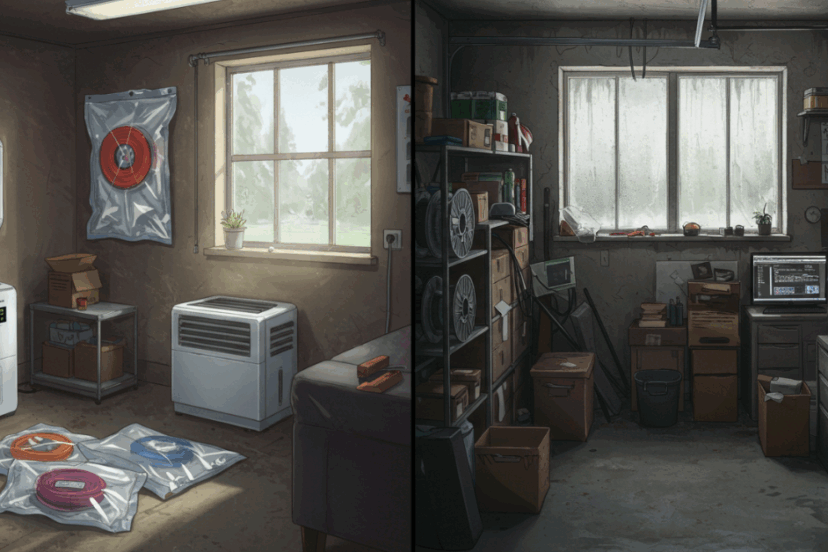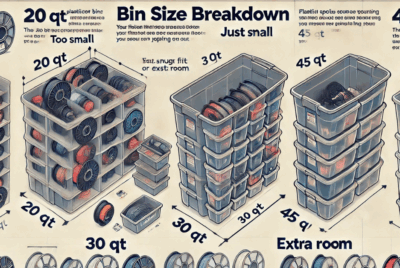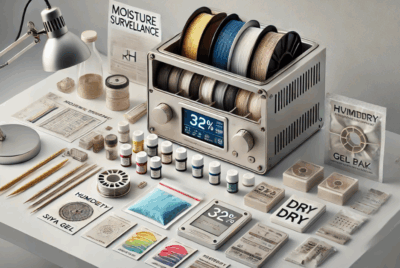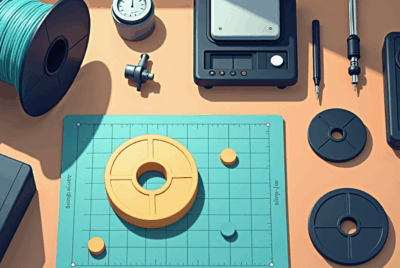How Does Ambient Humidity in Your Room Affect Filament?
1. The Air Around You Might Be Your Print’s Worst Enemy
You’ve calibrated your printer. You dried your filament. You dialed in the perfect slicer settings.
And still… your prints are failing.
What gives?
Chances are, your problem isn’t your printer. It’s your room—specifically, the humidity floating around in the air.
Let’s explore how ambient humidity quietly sabotages 3D printing and what you can do about it.
2. What Is Ambient Humidity?
Ambient humidity refers to the amount of moisture in the air around you—inside your room, garage, or workspace.
Measured as relative humidity (RH), it tells you how much water vapor the air is holding compared to its max capacity.
- 30% RH = dry
- 50% RH = average
- 70%+ RH = humid
And yes, filament soaks this stuff up like a sponge.
3. Why Filament Reacts to Humidity So Quickly
Most 3D printing filaments are hygroscopic—they absorb water molecules from the air over time.
Common examples:
Nylon: absorbs moisture in under 6 hours
PETG & TPU: degrade in high RH within 24 hours
PLA: more resistant but not immune
Moisture affects the filament’s molecular structure and ruins its ability to extrude smoothly.
4. Filament Materials Most Affected by Room Humidity
| Filament | Sensitivity to Ambient Humidity |
|---|---|
| Nylon | Extremely high |
| TPU | Very high |
| PVA | Extremely high |
| PETG | Moderate to high |
| PLA | Low to moderate |
Even low-sensitivity filaments like PLA will degrade over time in humid rooms.
5. How Humidity Gets Into Your Spools
Here’s how ambient humidity creeps in:
Leaving filament out on your desk
Opening sealed bins or bags too long
Storing spools near windows, vents, or sinks
Printing from non-sealed dry boxes
Using containers without refreshed desiccant
It doesn’t have to be soaking wet air. Just 40–50% RH is enough to slowly ruin your filament.
6. Signs That Ambient Humidity Has Affected Your Filament
Look for:
- Popping or sizzling during extrusion
- Stringing and blobs in prints
- Layer delamination or weak infill
- Clogged nozzles or gritty texture
- Filament that’s snapping or feels chalky
If you’ve been storing in an unmonitored room—it’s not your slicer. It’s the air.
7. Room Types That Tend to Be Humid Traps
Think your room is “probably fine”? Think again.
Problem spots:
- Garages (uninsulated, open air exposure)
- Basements (cool, damp, poor ventilation)
- Laundry rooms (high temp swings, moisture)
- Near bathrooms/kitchens
- Unsealed workshops or sheds
If you’re printing in one of these—check your RH levels immediately.
8. The Ideal Ambient Humidity for 3D Printing
Here’s the sweet spot for printing and storage:
| Filament Type | Ideal Room RH |
|---|---|
| PLA | < 40% |
| PETG / ABS | < 35% |
| TPU / TPE | < 30% |
| Nylon / PVA | < 25% |
Lower is better—but too low (under 15%) may cause static or brittle handling.
9. How to Measure Room Humidity Accurately
Use tools like:
- ThermoPro TP49 / TP67A (budget friendly)
- Govee Bluetooth Hygrometers (smart tracking)
- Inkbird ITH-20 or IBS-TH1 (high accuracy)
- Digital weather stations with remote sensors
Place sensors:
- Near your printer
- Inside your storage bins
- On a shelf with exposed spools
Monitor RH throughout the day—humidity fluctuates with weather and HVAC activity.
10. How Long Does It Take for Humidity to Ruin a Spool?
| Filament | Degrades In Room RH > 50% |
|---|---|
| Nylon | Within 6 hours |
| TPU | 6–12 hours |
| PETG | 24–48 hours |
| PLA | 2–5 days |
Even a few days in high humidity can send a previously perfect spool into print-fail territory.
11. How Temperature Swings Amplify Humidity Problems
Cold air holds less moisture. Warm air holds more.
When temps swing rapidly, condensation can form—especially inside bins or on spools.
This accelerates moisture absorption and can ruin your storage setup even if you used a sealed bin.
Solution: store filament in temperature-stable areas with low humidity.
12. Why “Room Temperature Storage” Isn’t Always Safe
“Room temperature” isn’t the problem—it’s uncontrolled room humidity.
Two rooms at 72°F can have vastly different RH levels:
- A room with HVAC and a dehumidifier = 🟢 filament-safe
- A room with poor airflow and leaky windows = 🔴 filament graveyard
Always measure—not assume.
13. Tools to Combat High Ambient Humidity
✅ Room Dehumidifiers – Lower overall RH
✅ Sealed Dry Boxes – Protect while printing
✅ Desiccant Packs + Hygrometers – Maintain sealed storage
✅ Climate-Controlled Cabinets – For serious makers or pros
✅ Smart Monitoring Apps – Track temp + humidity trends remotely
Pro tip: Run a dehumidifier during the day, and seal bins at night when RH tends to rise.
14. Tips for Protecting Filament in a Humid Room
Always store filament in vacuum-sealed bags with silica gel
Use airtight containers with hygrometers
Print directly from dry boxes with sealed feed ports
Place desiccant in open-air dry boxes and check weekly
Limit how long bins stay open
Install a room dehumidifier and monitor RH daily
Humidity is a silent killer. Beat it before it strikes.
15. Final Thoughts: Your Room’s Climate Controls Your Print
Even the best filament, printer, and slicer settings can’t compete with bad room conditions.
So if your prints are failing and you’ve done everything else right…
✅ Measure your ambient humidity.
✅ Control your room climate.
✅ Store smart, not loose.
Your filament isn’t just sitting in a box—it’s sitting in your environment.
Make sure that environment isn’t slowly ruining your prints.
❓FAQs
1. What’s the max safe humidity level for 3D printing rooms?
Keep it below 40% RH. For Nylon, TPU, or PVA, aim for under 30% RH.
2. Can I store filament in a room with 60% humidity?
Only if it’s in airtight vacuum-sealed bags with desiccant and not exposed to air.
3. How do I know if my room’s humidity is the issue?
Use a hygrometer to monitor RH. If prints get worse during humid weather or after storage, it’s likely the cause.
4. Should I use a dehumidifier in my print room year-round?
Yes—especially in basements, garages, or coastal areas. Keep RH stable for consistent print quality.
5. What’s the easiest way to monitor multiple storage areas?
Use Bluetooth humidity sensors with a mobile app. Govee and SensorPush are great options.




